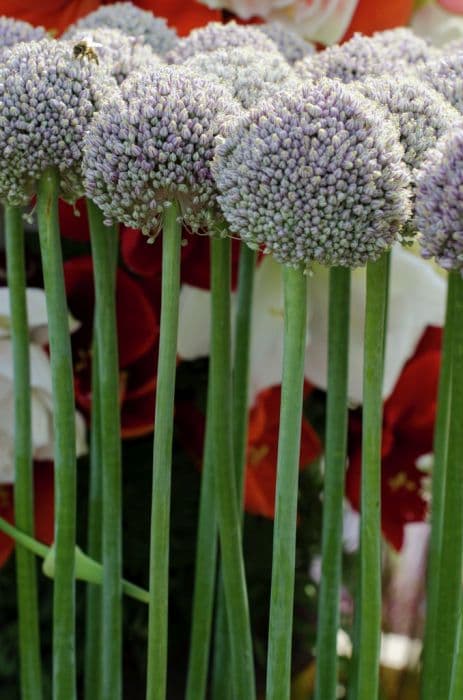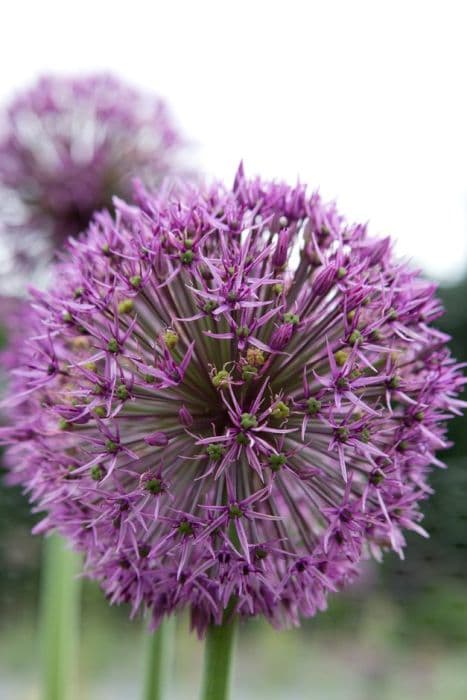Star of Persia Allium cristophii

ABOUT
Allium cristophii, commonly known as Star of Persia, is a highly ornamental onion species known for its striking and unique appearance. The most defining feature of this plant is its large, spherical flower head that bursts with numerous star-shaped, metallic lavender flowers. These blooms are clustered together in a tightly-packed, geometrically intriguing array, giving the impression of a floral fireworks display. The individual florets that make up the flower head have a silvery sheen and long, protruding stamens, which add to the starry effect. The flowers form a round, spiky globe that can be quite sizable. Blooming in late spring to early summer, the Star of Persia's flower heads sit atop sturdy, upright stems that rise above the foliage. The foliage consists of broad, strap-shaped leaves that are typically a grayish-green color. These leaves form a lush, basal cluster that provides a contrasting backdrop to the dramatic flower heads suspended above. After blooming, the seed heads maintain an ornamental quality, often remaining attractive even as they dry on the plant. Overall, the beauty of the Star of Persia lies not only in its show-stopping flower heads but also in its architectural form and the contrast between its bold blooms and the more subdued tones of its foliage.
About this plant
 Names
NamesFamily
Amaryllidaceae
Synonyms
Star Of Persia, Christoph's Onion, Persian Onion
Common names
Allium albopilosum, Allium bodeanum.
 Toxicity
ToxicityTo humans
The Allium cristophii, commonly known as the Star of Persia, is not considered highly toxic to humans. While eating large quantities of the plant, particularly the bulbs, may cause digestive discomfort, such as nausea, vomiting, or diarrhea, typical casual contact or small culinary uses are generally safe. As with any plant, individuals with specific allergies to this genus may experience adverse reactions.
To pets
The Allium cristophii, known as the Star of Persia, is toxic to pets, especially cats and dogs. This toxicity is due to the presence of organosulfur compounds in the plant. If pets ingest parts of the Star of Persia, symptoms of poisoning may include vomiting, diarrhea, abdominal pain, lethargy, and elevated heart rate. In severe cases, ingestion may lead to oxidative damage to red blood cells, which can cause anemia. If you suspect your pet has ingested this plant, it is important to seek veterinary care promptly.
 Characteristics
CharacteristicsLife cycle
Perennials
Foliage type
Deciduous
Color of leaves
Green
Flower color
Purple
Height
2 feet [60 cm]
Spread
1 foot [30 cm]
Plant type
Bulb
Hardiness zones
4
Native area
Central Asia
Benefits
 General Benefits
General Benefits- Ornamental value: The Allium cristophii, commonly known as Star of Persia, is prized for its striking spherical flower heads that can add visual interest to any garden or floral arrangement.
- Attracts pollinators: The vibrant flowers of the Star of Persia draw in bees, butterflies, and other pollinating insects, which is beneficial for the overall health of a garden ecosystem.
- Drought resistance: This plant is well-suited to dry conditions and is an excellent choice for water-wise gardens.
- Deer and rodent resistance: The Star of Persia has a natural resistance to deer and rodents, reducing the need for chemical repellents in the garden.
- Easy to grow: It requires minimal maintenance, making it a great option for both beginner and experienced gardeners.
- Edible parts: While not commonly consumed, the bulbs and flowers of the Star of Persia are technically edible and have been used in some regional cuisines.
 Medical Properties
Medical PropertiesThis plant is not used for medical purposes.
 Air-purifying Qualities
Air-purifying QualitiesThis plant is not specifically known for air purifying qualities.
 Other Uses
Other Uses- Allium cristophii, commonly known as Star of Persia, can be used as a natural dye, with the plant's flowers providing a range of colors when used in fabric dyeing processes.
- The dried flower heads of Star of Persia can be used in floral arrangements, adding a unique and lasting element to bouquets or home decorations.
- These plants can be used as companion plants in the garden to help deter certain pests that might otherwise damage more vulnerable plants.
- Star of Persia can be employed in landscape design to create dramatic visual patterns and to take advantage of its structural look in modern gardens.
- The flower heads can be used in craft projects, for example, to create natural wreaths or other ornamental items.
- Star of Persia's seed pods can be used as a natural rattling sound in homemade musical instruments or children's toys.
- The robust stems of Star of Persia can provide natural support to more delicate plants in a mixed garden bed.
- Because of their attractiveness to bees and other pollinators, these plants can be used in efforts to promote biodiversity within urban gardening projects.
- The stark, geometric shape of the Star of Persia blooms can serve as inspiration for artists and designers in various mediums from graphic design to textiles.
- Star of Persia can be planted as part of a wildlife garden aimed at providing food and shelter for birds who might eat the seeds from spent flower heads.
Interesting Facts
 Feng Shui
Feng ShuiThe Star of Persia is not used in Feng Shui practice.
 Zodiac Sign Compitability
Zodiac Sign CompitabilityThe Star of Persia is not used in astrology practice.
 Plant Symbolism
Plant Symbolism- Unity and Humility: The spherical shape of Allium cristophii, commonly known as Star of Persia, is often seen as a symbol of unity, because it is comprised of numerous small flowers coming together to form a whole. It also represents humility due to its origins in the mountains and its modest, yet striking, appearance.
- Patience and Perseverance: As the Star of Persia takes time to grow and bloom, it is seen as a symbol of patience and perseverance, telling the story of beauty that comes with time and care.
- Good Fortune and Prosperity: In some cultures, Allium cristophii is given to wish the recipient prosperity and good luck, as it is believed that the plant attracts positive energy and abundance.
- Strength and Resilience: The sturdy stems and the plant's ability to thrive in a variety of soils represent strength and resilience, encouraging individuals to stand strong in the face of adversity.
- Protection: Throughout history, Allium species have been believed to offer protection against evil spirits and negative influences, thus the Star of Persia also carries this symbolic meaning.
 Water
WaterStar of Persia should be watered moderately once the soil begins to dry out. They require less water than many other garden plants, and it's essential to avoid overwatering to prevent root rot. During the growing season, water approximately once every week or two, using around 1 gallon of water per square yard, assuming the plant is in the ground. If grown in containers, check the soil more frequently and water when the top inch of soil feels dry, which might be once or twice a week depending on weather conditions. Water the soil directly, avoiding wetting the foliage to reduce the risk of fungal diseases.
 Light
LightStar of Persia thrives best in full sun conditions. This means placing the plant in a location where it can receive at least 6 to 8 hours of direct sunlight each day. They adapt well to areas that have unfiltered sunlight for most of the day, making them ideal for sunny borders, open meadows, or rock gardens with minimal shading.
 Temperature
TemperatureStar of Persia prefers temperate climates with temperatures ranging between 50°F and 75°F during its active growth phase. The plant can tolerate temperatures as low as 28°F without significant damage but is not suited for extreme cold or frost. Ideal growth occurs in a climate where extreme heat or cold is not prevalent, making spring and autumn temperatures optimal for this plant.
 Pruning
PruningPruning Star of Persia is not typically necessary for the health of the plant but may be done to maintain appearance or control size. After the flowers have faded and the plant has gone dormant, usually in late summer or early fall, the dried flower stalks can be cut back to the ground. This is also the best time to divide clumps if necessary, as it can help promote vigorous growth for the following season.
 Cleaning
CleaningAs needed
 Soil
SoilStar of Persia (Allium cristophii) thrives in well-draining soil with a neutral to slightly alkaline pH of 6.5 to 7.5. A soil mix composed of garden soil, compost, and sand or perlite to enhance drainage can be ideal. Ensure the soil is fertile and has adequate organic matter for nutrients.
 Repotting
RepottingStar of Persia (Allium cristophii) typically does not require frequent repotting. It is repotted every 3-4 years, or when the bulbs have outgrown their current space. It's best to repot after the foliage has died back.
 Humidity & Misting
Humidity & MistingStar of Persia (Allium cristophii) is tolerant of a wide range of humidity levels and does not require high humidity. It thrives in outdoor conditions with natural airflow, thus prefers standard outdoor humidity levels.
 Suitable locations
Suitable locationsIndoor
Place in bright light, well-draining soil, water sparingly.
Outdoor
Full sun, fertile, well-draining soil, space bulbs 8 inches.
Hardiness zone
4-9 USDA
 Life cycle
Life cycleAllium cristophii, commonly known as Star of Persia, begins its life cycle from a bulb, which remains dormant underground during winter. In early spring, the bulb sends up a basal rosette of leaves followed by a tall flower stalk, culminating in a spherical umbel of star-shaped, purple flowers by late spring or early summer. After blooming, the plant sets seed, which can be collected from the dried flower heads for propagation, and as summer progresses, the foliage yellows and dies back as the plant enters a period of dormancy. The cycle repeats the following spring, with the bulb regenerating its foliage and blooms anew. Throughout its life, Star of Persia requires a period of cold dormancy to trigger subsequent flowering. Over time, the bulbs may naturally multiply, creating larger clumps of the plant.
 Propogation
PropogationPropogation time
Spring
The most popular method of propagation for Allium cristophii, commonly known as Star of Persia, is by division of bulbs. The best time to propagate this plant by dividing the bulbs is during its dormancy period, which typically falls in late summer to early fall, after the foliage has died down. To divide the bulbs, carefully dig up the clump of bulbs and gently separate them by hand, making sure that each newly divided bulb has a portion of the basal plate (the bottom part where the roots grow out). Once divided, these bulbs should be immediately replanted at a depth of three times their height in well-draining soil, spaced about 8 to 12 inches (approximately 20 to 30 centimeters) apart to ensure adequate room for growth. The divided bulbs will then go on to produce new plants that will flower the following season.









